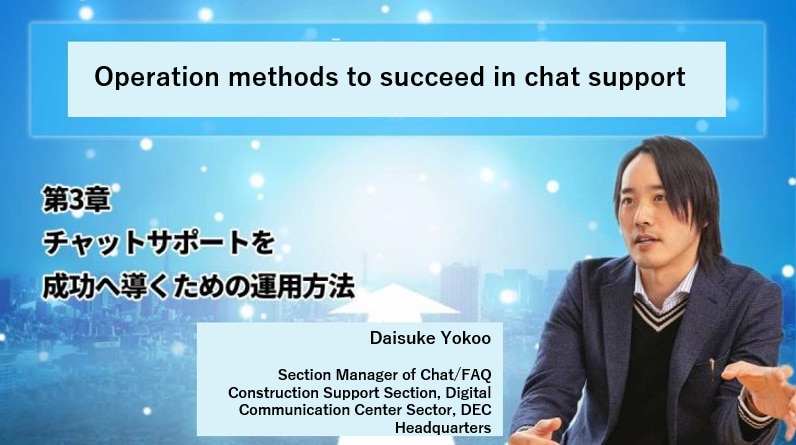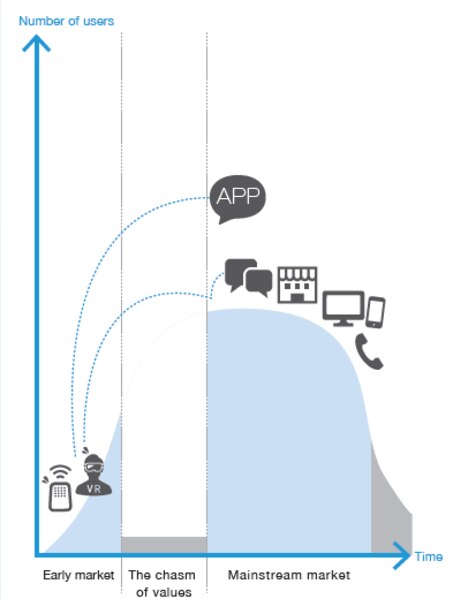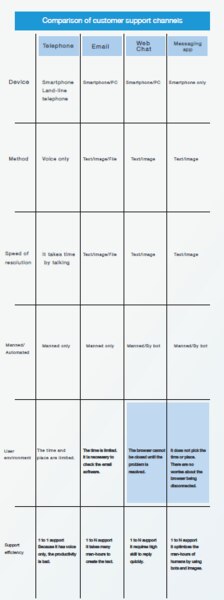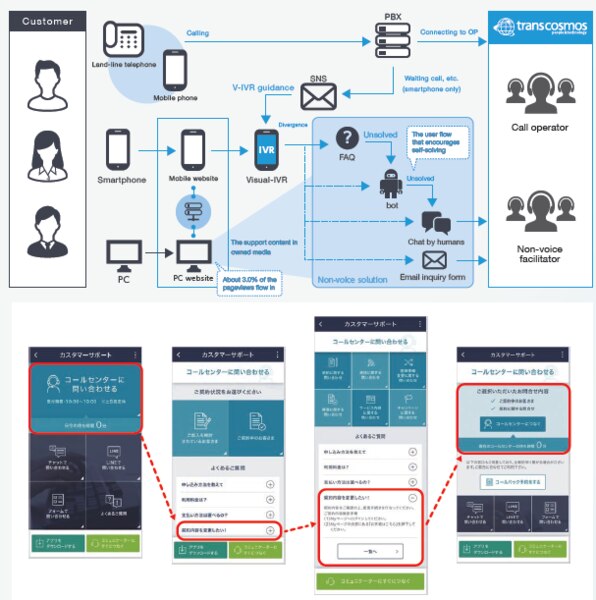
The Cutting Edge of Contact Centers - Chapter 3 -
Interactive AI system will widespread, and the market size will get 5 times or larger by 2022.
In recent years, in order to make up for workforce in the age of "super" labor shortage at contact centers, the tool infrastructure improvement is accelerated to set interactive AI system with text and speech interfaces, and the contact centers utilizing chat support are rapidly increasing.
The shift to non-voice contact centers has been progressing rapidly since around 2016. According to "White Paper on Call Center 2018 (RIC TELECOM)", compared to 2017, the number of contact centers responsive to chat service has increased by approximately 1.6 times in 2018, and the number of messaging apps like LINE has increased by 3.8 times.
Furthermore, some statistics show that, with the Tokyo Olympic and Paralympic Games scheduled in 2020 serving as a tailwind, the use of interactive AI systems for customer service continues to expand, and the market size is expected to increase by 5.5 times from 2018 to 2022.
However, in other statistics, the use of chat support accounts for only about 6% in Japan. This is far lower than in other countries. On the other hand, chat has been already an essential support channel for customers overseas.
A similar example that only the Japanese market has a low penetration is the cashless payment market. Cashless is convenient, but cash also functions well without much difficulty. Chat is convenient in the same way, but there is no big problem with telephone and email. As a result, both tend to lag behind in penetration.
However, if Apple's Business Chat Suggest (a function when you tap the phone number of a company that supports Business Chat it gives suggestion to start a chat) or Google's Business Listing in the My Business app (a function users who found the company's business listing can reply messages) become the catalysts, consumers will realize the benefits of chat service more broadly, and non-voice chat could quickly become widespread.
This trend of shift to non-voice is not just caused by the lack of labor for the companies' convenience.
As shown in Figure 1, transcosmos's original research of "Survey on Consumer and Corporate Communication" shows that while "Telephone," "Website," and "Store/Storefront" are used as so-called "Conventional channels," "Chat" and "Messaging app" crossed the penetration division commonly known as "Chasm," with user experience soaring to nearly 20%. They have become widespread as means of communication between consumers and the company.

Figure 1: "Chat" and "Messaging app" crossed the "Chasm" of penetration.
In this way, we can see expectations for non-voice support like chat and LINE from the needs of consumers who make inquiries.
Why do we stumble over when introducing chat?
Then, how should we go ahead with introducing chat at contact centers?
At transcosmos, we categorize the basic steps for introducing chat into 4 phases: (1) project design, (2) data collection and analysis, (3) preparation for introduction, and (4) production testing.
In each of the phases (1) to (4), the following "stumbling blocks" exist.
In the beginning, one of the most common stumbling blocks in the phase (1) project design is to make introduction of an interactive AI system into the goal itself, which makes project design mediocre.
This is a failure that tends to occur when discussions are made top-down. There are quite common cases that, they introduced a system without a specific purpose after their competitor had introduced the same system, or when AI or chat attracts attention they make a big plan (dream) from their over-expectation.
In other common cases, due to the limited budget for chat arising from the lack of understanding from the top and other departments, they often introduce an inexpensive tool first and the tool ends up in not usable for practice, or due to designing only the chat channel instead of entire channel, and the user flow to chat is not prepared. It is necessary to define the most important purpose in introducing chat, and select a chat tool that matches the purpose and the measures.
Secondly, there are many cases that the staff proceed with introducing chat without understanding the importance of the (2) data collection and analysis in advance, and they stumble later.
There are endless troubles such as, people do not analyze whether customer support desk tasks planned to introduce chat service is suitable for chat in the first place, they do not optimize the knowledge base (FAQ) of both outside and inside the company that is a prerequisite for introducing chat, or they introduce chat without knowing the inflow path to each channel and the access status to official websites. Such cases happen only because they discount the importance of previous data collection and analysis step, and just start the tool introduction.
Thirdly, we can see a failure that users cannot reach a solution due to problems with the inflow path from the official website to the chat or due to the trouble that users loop back to the questions caused by wrong scenario design. In particular, the link to the chat on the official website is at an obscure place, or many users abandon in the middle because only the necessary scripts are registered for the bot and there are no witty aside or chatting in it. To a degree, some of these cases can be improved in the PDCA cycle after introducing chat.
However, the problem is that in many cases the PDCA cycle does not work because the KPI for identifying the improvement target is not set in the first place or because their numerical goal and calculation method are ambiguous. Therefore, we need to set a clear KPI in the preparation phase of (3) before introducing chat service.
Finally, as an example of a stumbling blocks in the (4) production testing, people cannot distinguish between "inquiries that bots should answer" and "inquiries that humans should handle.” Even after starting operation, there are cases that they have difficulty having users try to chat or raising resolution rate, and CX may rather go down. These problems can often be avoided by performing a thorough production testing, maintaining the bot, and then moving to the production.
However, there are cases that the analysis function of the tool is weak, or even though the number of inflows is small in the first place, they chase a good KPI including the resolution rate and the number of simultaneous responses. Depending on the production testing results, we may need to review the tools we selected and the KPI we set up in the previous phase.
Keys to succeed by phase in the introduction of chat
So what are the "keys to succeed" that should be done in each phase to avoid these "stumbling blocks"? Let's take a closer look at each phase.
(1) Key to succeed in the phase of project design
In the phase of project design, the important thing is to set up objectives for introducing chat. We should define the most important objective whether we want to reduce costs, improve CX, or improve Conversion Rate (CVR). Then we need to clarify the content of measures and select a chat tool that meets its objective and measures.
1. If we aim at contact center's "cost reduction"
In this case, a realistic approach is to reduce the total cost of contact centers by labor cost reduction with bot automatic response and by optimization even in manned operation with simultaneous 1 to N response and image sharing that shortens response time. For such purposes, transcosmos's "DEC Support" and "Chat Plus" may be good chat tool options.
2. If we aim at "CX improvement" through expansion of touchpoints
To thoroughly differentiate our products and services, we could take the measure that strengthens the brand through customer care and after-sales support on the Internet. Internet customer service tools like PLAID's "KARTE" have the features that suit for this purpose.
3. If we aim at "CVR improvement" by supporting purchase and increasing consumer demand
We can provide customer service through chat, which realizes real-time responses and smooth flow in the purchase support. To realize this service, the chat concierge "ShowTalk" is a popular solution.
For your information, I mentioned the 3 typical examples above as the purposes of the chat introduction, but there are also secondary effects such as Employee Satisfaction (ES) improvement, decrease in turnover rate, reduction of employment cost, analysis and utilization of VOC data, and approach to potential customers. I hope this helps.
In addition, there is another important thing in the phase of project design. What is important is not just to think about a single chat service, but be aware of the role and positioning of chat in all the customer contact channels.
As shown in Figure 2, there are different detailed functions, advantages, and disadvantages between chat and other channels like telephone and email. Even among the similar chat functions of messaging apps such as webchat and LINE, there are such differences.

Figure 2: Customer support channel comparison
Depending on the characteristics of the company's industry or services, we should take into account the advantages we value, such as "availability regardless of time or place" or unacceptable disadvantages, such as "web browser can't be closed until the problem resolved." Then we should consider channel mixing that combines multiple measures to complement each other.
(2) Key to succeed in the phase of data collection, analysis and design
In the phase of data collection, analysis and design, we should check to see if the customer support of the company is suitable for chat in the first place, and then we focus on optimizing both external and internal knowledge base (FAQ).
Specifically, we should analyze whether we can give similar answers to the existing inquiries to contact centers across the board, or whether individual responses and human judgment are necessary.
As a result of that, we classify all the inquiries, and in advance calculate the prospect and cost of each channel after introducing the chat in this way: x% should be responded by phone, x% possibly can be changed into chat response, x% can be fully handled by chat from this moment, and x% of the previous category can be handled with automatic response.

Figure 3: Knowledge base (FAQ) optimization by content coverage analysis
Besides, we analyze the obsolescence of knowledge base (FAQ) that underlies customer service across all channels. Then as shown in Figure 3, we measure the inquiries covered by FAQ of all inquiries (content coverage ratio), and if possible, we try to increase the coverage ratio of FAQ on the external support webpage to 70%, and raise the one on the internal support knowledge base webpage close to 90%.
If we fail to optimize knowledge base like this, even if we introduce manned chat, we may end up with problems such as longer response times and an increase in the number of unsolved cases by bots.
(3) Key to succeed in the phase of preparation for introduction
In the phase of preparation for introduction, we design user flow and set up KPI to optimize the inflow path for each channel.
The increase in inflows is limited by just installing chat service, and the essential utilization rate does not rise. Accordingly, as shown in Figure 4, it is necessary to secure inflow path guiding from telephone or the Internet to chat.
Unfortunately, many companies cannot improve the user flow as intended since the website is outside the scope of call centers. They have not known their current state because they even did not analyze user flow from the home page of website to the support content.
When introducing chat, however, it is essential to ensure a smooth user flow from the Internet. Therefore, we need to work thoroughly across channels and organizational boundaries. In fact, a home electronics manufacturer introduced "V-IVR" (a system that visually guides users to manned chat or bots on the smartphone screen) on the home page of support webpage, and succeeded in increasing the inflow by 327%.

Figure 4: Illustration of user flow path design and chat guidance with V-IVR
In the phase of preparation for introduction, it is necessary to consider KPI setting and reporting items for the operation and management, set up the character (persona), tone, and manner of the responding person, and then build operating systems including workflow creation, hiring, and training. While many of these preparatory tasks are similar to contact center tasks of telephone and email handling, the KPI in bot support has a few unique metrics which are specific to bots.
One of them is bot option display rate. This is a metric of how well the bot gives the answer options to bot users. If this number is small, it means that too few Q&A items are registered to provide answer options to the customer and the final resolution rate is low, so it needs to expand the Q&A knowledge base.
Another unique bot metric is the Q&A hit ratio. This is a metric of how well the bot responds Q&A that matches the customer's question. If the number is low, it is possible that the bot suggests incorrect answer options, and it means that the final resolution rate is low, therefore, the logic of displaying answer options needs review.
(4) Key to succeed in the phase of production testing
In the final phase of production testing, as shown in Figure 5, we classify "inquiries that bots can answer" and "inquiries that humans should handle" in the trial, and fix the bot for production.
Here it is important to check whether the inquiries resolved by bots of the total inquiries is between 20% to 40%, and then among the unsolved inquiries, analyze and fix the inquiries except for the ones that are explicitly judged as "inquiries not resolved" in the user questionnaire answers.

Figure 5: Clarification of "inquiries that bots can answer" and "inquiries that humans should handle"
There are several patterns in how to calculate a bot resolution rate depending on how the parameter is defined, for instance, whether we include the number of bot use, questionnaire answers, FAQs, and the number which includes guidance for fixing. The number of resolutions without questionnaire answer replies may be calculated as an apparent resolution based on the questionnaire response rate. For these cases, it is desirable to set the appropriate parameter of the resolution rate according to the purpose of the bot introduction.
At transcosmos, we measure other companies' examples or benchmark average values in each KPI, such as the bot resolution rate and feedback rate in each calculation method. We would be grateful if you contact us when introducing bots.
Enthusiasm enough to aim for "eliminating telephone contact desk" is needed.
So far, we've covered the "stumbling blocks" and "keys to succeed" in each phase for chat introduction.
Again, it is important to clarify the objectives and role of chat introduction considering the entire structure of contact channel. After that, it is the "path to succeed" that we analyze in advance whether the inquiry content is suitable for chat response and FAQ is fully fixed as a knowledge base, then we thoroughly maintain it to secure the inflow path to the chat contact desk and improve the bot resolution rate.
Finally, I would like to leave you with a message for the personnel who are promoting or introducing chat.
In fact, when chat is introduced, inquiries from new users arise due to the expansion of touchpoints, and mostly inquiries increase in the contact center as a whole. When it happens, if the company introduced chat for "cost reduction," they tend to think that this is putting the cart before the horse, and give up promoting chat support.
However, from a different perspective, this is a testament to the fact that they are responding to the needs and frustrations of silent customers and are making a solid contribution to improve the CX and strengthen the brand. And if we continue to improve bots and enhance chat support, we will be able to achieve cost-effective customer support.
Therefore last of all, I would like to emphasize that the "enthusiasm" of those who promote the introduction of chat is the most important.
This may sound like an extreme expression, but in the end, I think we cannot continue our efforts to promote the shift to non-voice service without the belief in the value and power of chat support or "enthusiasm" enough to aim for "eliminating telephone contact desk." I hope that our company's efforts will be of some help to those who have such enthusiasm.
transcosmos is a global and one-stop solution provider that offers digital marketing, 5A analysis, eCommerce and contact center support that adds value through optimizing cost and driving sales. For more information, please feel free to email us at; |
Let’s talk ✉:sales_global@ml01.trans-cosmos.co.jp |













